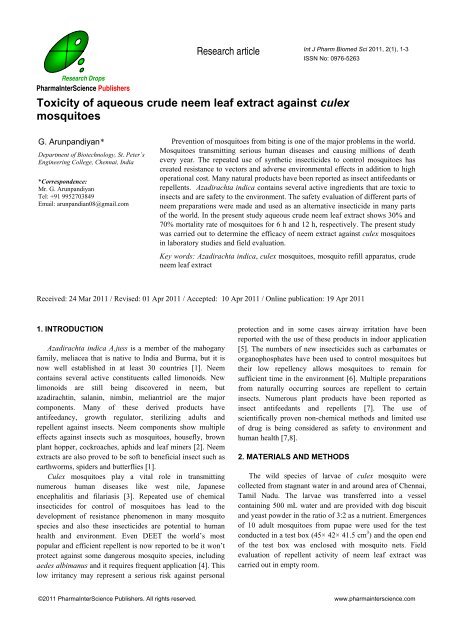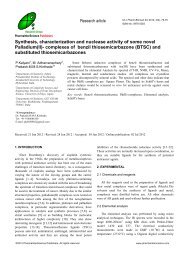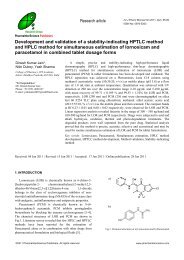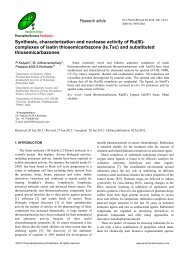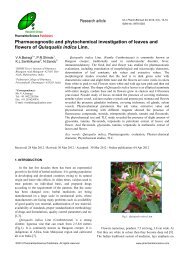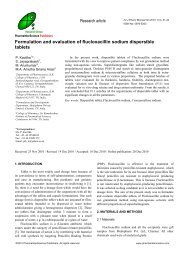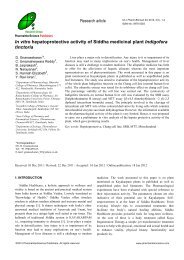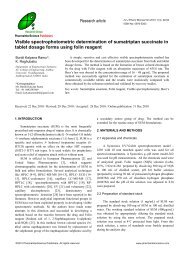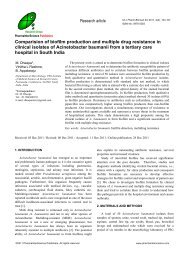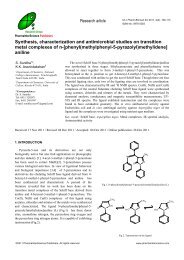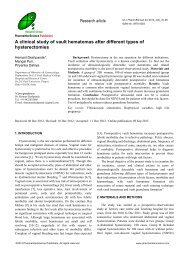Toxicity of aqueous crude neem leaf extract against culex mosquitoes
Toxicity of aqueous crude neem leaf extract against culex mosquitoes
Toxicity of aqueous crude neem leaf extract against culex mosquitoes
Create successful ePaper yourself
Turn your PDF publications into a flip-book with our unique Google optimized e-Paper software.
Research article<br />
Int J Pharm Biomed Sci 2011, 2(1), 1-3<br />
ISSN No: 0976-5263<br />
Research Drops<br />
PharmaInterScience Publishers<br />
<strong>Toxicity</strong> <strong>of</strong> <strong>aqueous</strong> <strong>crude</strong> <strong>neem</strong> <strong>leaf</strong> <strong>extract</strong> <strong>against</strong> <strong>culex</strong><br />
<strong>mosquitoes</strong><br />
G. Arunpandiyan*<br />
Department <strong>of</strong> Biotechnology, St. Peter’s<br />
Engineering College, Chennai, India<br />
*Correspondence:<br />
Mr. G. Arunpandiyan<br />
Tel: +91 9952703849<br />
Email: arunpandian08@gmail.com<br />
Prevention <strong>of</strong> <strong>mosquitoes</strong> from biting is one <strong>of</strong> the major problems in the world.<br />
Mosquitoes transmitting serious human diseases and causing millions <strong>of</strong> death<br />
every year. The repeated use <strong>of</strong> synthetic insecticides to control <strong>mosquitoes</strong> has<br />
created resistance to vectors and adverse environmental effects in addition to high<br />
operational cost. Many natural products have been reported as insect antifeedants or<br />
repellents. Azadirachta indica contains several active ingredients that are toxic to<br />
insects and are safety to the environment. The safety evaluation <strong>of</strong> different parts <strong>of</strong><br />
<strong>neem</strong> preparations were made and used as an alternative insecticide in many parts<br />
<strong>of</strong> the world. In the present study <strong>aqueous</strong> <strong>crude</strong> <strong>neem</strong> <strong>leaf</strong> <strong>extract</strong> shows 30% and<br />
70% mortality rate <strong>of</strong> <strong>mosquitoes</strong> for 6 h and 12 h, respectively. The present study<br />
was carried out to determine the efficacy <strong>of</strong> <strong>neem</strong> <strong>extract</strong> <strong>against</strong> <strong>culex</strong> <strong>mosquitoes</strong><br />
in laboratory studies and field evaluation.<br />
Key words: Azadirachta indica, <strong>culex</strong> <strong>mosquitoes</strong>, mosquito refill apparatus, <strong>crude</strong><br />
<strong>neem</strong> <strong>leaf</strong> <strong>extract</strong><br />
Received: 24 Mar 2011 / Revised: 01 Apr 2011 / Accepted: 10 Apr 2011 / Online publication: 19 Apr 2011<br />
1. INTRODUCTION<br />
Azadirachta indica A.juss is a member <strong>of</strong> the mahogany<br />
family, meliacea that is native to India and Burma, but it is<br />
now well established in at least 30 countries [1]. Neem<br />
contains several active constituents called limonoids. New<br />
limonoids are still being discovered in <strong>neem</strong>, but<br />
azadirachtin, salanin, nimbin, meliantriol are the major<br />
components. Many <strong>of</strong> these derived products have<br />
antifeedancy, growth regulator, sterilizing adults and<br />
repellent <strong>against</strong> insects. Neem components show multiple<br />
effects <strong>against</strong> insects such as <strong>mosquitoes</strong>, housefly, brown<br />
plant hopper, cockroaches, aphids and <strong>leaf</strong> miners [2]. Neem<br />
<strong>extract</strong>s are also proved to be s<strong>of</strong>t to beneficial insect such as<br />
earthworms, spiders and butterflies [1].<br />
Culex <strong>mosquitoes</strong> play a vital role in transmitting<br />
numerous human diseases like west nile, Japanese<br />
encephalitis and filariasis [3]. Repeated use <strong>of</strong> chemical<br />
insecticides for control <strong>of</strong> <strong>mosquitoes</strong> has lead to the<br />
development <strong>of</strong> resistance phenomenon in many mosquito<br />
species and also these insecticides are potential to human<br />
health and environment. Even DEET the world’s most<br />
popular and efficient repellent is now reported to be it won’t<br />
protect <strong>against</strong> some dangerous mosquito species, including<br />
aedes albimanus and it requires frequent application [4]. This<br />
low irritancy may represent a serious risk <strong>against</strong> personal<br />
protection and in some cases airway irritation have been<br />
reported with the use <strong>of</strong> these products in indoor application<br />
[5]. The numbers <strong>of</strong> new insecticides such as carbamates or<br />
organophosphates have been used to control <strong>mosquitoes</strong> but<br />
their low repellency allows <strong>mosquitoes</strong> to remain for<br />
sufficient time in the environment [6]. Multiple preparations<br />
from naturally occurring sources are repellent to certain<br />
insects. Numerous plant products have been reported as<br />
insect antifeedants and repellents [7]. The use <strong>of</strong><br />
scientifically proven non-chemical methods and limited use<br />
<strong>of</strong> drug is being considered as safety to environment and<br />
human health [7,8].<br />
2. MATERIALS AND METHODS<br />
The wild species <strong>of</strong> larvae <strong>of</strong> <strong>culex</strong> mosquito were<br />
collected from stagnant water in and around area <strong>of</strong> Chennai,<br />
Tamil Nadu. The larvae was transferred into a vessel<br />
containing 500 mL water and are provided with dog biscuit<br />
and yeast powder in the ratio <strong>of</strong> 3:2 as a nutrient. Emergences<br />
<strong>of</strong> 10 adult <strong>mosquitoes</strong> from pupae were used for the test<br />
conducted in a test box (45× 42× 41.5 cm 3 ) and the open end<br />
<strong>of</strong> the test box was enclosed with mosquito nets. Field<br />
evaluation <strong>of</strong> repellent activity <strong>of</strong> <strong>neem</strong> <strong>leaf</strong> <strong>extract</strong> was<br />
carried out in empty room.<br />
©2011 PharmaInterScience Publishers. All rights reserved. www.pharmainterscience.com
G. Arunpandiyan et al., Int J Pharm Biomed Sci 2011, 2(1), 1-3<br />
2<br />
Five grams <strong>of</strong> fresh <strong>neem</strong> leaves were collected and<br />
washed with distilled water. Using mortar and pestle the<br />
<strong>neem</strong> leaves were grounded into thick paste and then 45mL<br />
<strong>of</strong> distilled water are added to collect <strong>aqueous</strong> form <strong>of</strong> <strong>crude</strong><br />
<strong>neem</strong> <strong>leaf</strong> <strong>extract</strong>. This methodology is easily adopted by<br />
local population and to be low cost. The prepared <strong>neem</strong><br />
<strong>extract</strong> was then transferred into a mosquito refill apparatus<br />
as shown in Fig.1. Three replicates <strong>of</strong> same concentration<br />
were carried out along with the control.<br />
Fig.2. <strong>Toxicity</strong> <strong>of</strong> <strong>aqueous</strong> <strong>neem</strong> <strong>extract</strong> <strong>against</strong> <strong>culex</strong> mosquito in the<br />
netted enclosure test box<br />
Fig.1 Mosquito refill apparatus containing the <strong>aqueous</strong> <strong>neem</strong> <strong>leaf</strong> <strong>extract</strong>.<br />
In the control, 1% ethanol was added instead <strong>of</strong> <strong>neem</strong><br />
<strong>extract</strong>. The mosquito refill apparatus is connected to the<br />
electric vaporizer and is kept inside the test box. The<br />
mortality rate was monitored at an interval <strong>of</strong> 6 h for 12 h.<br />
The mortality rate was calculated by using Abbot’s formula<br />
[9].<br />
Fig.3. Mosquitoe get attached to the support as the vapors <strong>of</strong> <strong>neem</strong> <strong>leaf</strong><br />
emitted<br />
3. RESULTS AND DISCUSSION<br />
The mortality rate was found to be 30% and 70% for 6 h<br />
and 12 h respectively. In the control group no mortality was<br />
recorded. These studies indicates that <strong>neem</strong> based pesticides<br />
are not rapidly lead to mortality but it can cause certain<br />
changes in their activity. The biological activity <strong>of</strong> the plant<br />
<strong>extract</strong> might be due to active compounds in <strong>neem</strong> including<br />
phenolics, terpenoids, and alkaloids [10]. These compounds<br />
may contribute to the death <strong>of</strong> <strong>mosquitoes</strong>. The electric<br />
vaporizer starts to emit vapors <strong>of</strong> <strong>neem</strong> <strong>leaf</strong> <strong>extract</strong> that<br />
disturb the <strong>mosquitoes</strong> from flying and they fall down within<br />
10 min but didn’t kill the <strong>mosquitoes</strong>. Some <strong>mosquitoes</strong><br />
showed swirling movement at the end <strong>of</strong> 25 min treatment<br />
with <strong>neem</strong> <strong>extract</strong>. The toxic effect <strong>of</strong> <strong>neem</strong> <strong>leaf</strong> <strong>extract</strong><br />
<strong>against</strong> <strong>culex</strong> <strong>mosquitoes</strong> in the netted enclosure was shown<br />
in Fig.2. In the field trials, the result indicates that the<br />
<strong>mosquitoes</strong> are repelled within 1 h and some changes are<br />
observed in the <strong>mosquitoes</strong> are, they get attached to any<br />
support the vapors <strong>of</strong> <strong>neem</strong> <strong>leaf</strong> <strong>extract</strong> emitted as shown in<br />
Fig.3, and some <strong>mosquitoes</strong> shown swirling movement for a<br />
short period as shown in Fig.4.<br />
Fig.4. <strong>Toxicity</strong> <strong>of</strong> <strong>aqueous</strong> <strong>neem</strong> <strong>extract</strong> <strong>against</strong> <strong>culex</strong> mosquito in open areas<br />
The result indicates that the immediate contact <strong>of</strong><br />
<strong>mosquitoes</strong> with the vapor <strong>of</strong> <strong>neem</strong> <strong>leaf</strong> <strong>extract</strong> leads to<br />
increase the mortality rate as the time <strong>of</strong> treatment increases.<br />
In addition to the insecticidal activity <strong>neem</strong> products also<br />
reported to be anti-inflammatory, antipyretic, antimalarial,<br />
antibacterial and anticancer activity. A paste prepared with<br />
©2011 PharmaInterScience Publishers. All rights reserved. www.pharmainterscience.com
G. Arunpandiyan et al., Int J Pharm Biomed Sci 2011, 2(1), 1-3<br />
<strong>neem</strong> and turmeric was found to be effective in the treatment<br />
<strong>of</strong> scabies in nearly 814 people. A recent study has been<br />
carried out to see the efficacy <strong>of</strong> <strong>neem</strong> <strong>extract</strong> to treat the<br />
malarial patients severely infected with<br />
plasmodiumfalciparum [11]. The bioactive compounds<br />
azadirachtin showed complete ovicidal activity in the eggs <strong>of</strong><br />
<strong>culex</strong> tarsalis and <strong>culex</strong> quinquefasciatus. The maximum<br />
protection was observed in methanolic and ethyl acetate<br />
<strong>extract</strong> exerted a protection time <strong>of</strong> more than 3 h for<br />
cucurbita maxima and c. colocynthis [12]. Repellent activity<br />
was assessed by topical application <strong>of</strong> the test sample to the<br />
ventral surface <strong>of</strong> test rodents and subsequent exposure <strong>of</strong> the<br />
treated area to unfed female <strong>mosquitoes</strong>. The <strong>crude</strong> <strong>extract</strong>s<br />
from ethnomedical plants were found to be effective as 80%<br />
repellency <strong>against</strong> <strong>culex</strong> <strong>mosquitoes</strong> [13]. Petroleum ether<br />
<strong>extract</strong> <strong>of</strong> Zanthoxylemlimonella were found equally effective<br />
and afforded significantly the better protection time than the<br />
oil <strong>of</strong> Citrusaurantifolia at 10% concentration in mustard oil<br />
[14]. All parts <strong>of</strong> <strong>neem</strong> tree contain bitter compounds that<br />
<strong>of</strong>ten have an antifeedants effect and can interfere with<br />
hormonal processes in insects. Extracts from the <strong>neem</strong> are<br />
<strong>of</strong>ten mixed with seeds to protect it <strong>against</strong> insects upon<br />
storage [15]. The <strong>neem</strong> based pesticides does not rapidly<br />
knockdown insects it might be an advantage it to be used as<br />
an alternative pesticides for control <strong>of</strong> vector-borne diseases<br />
without any side effects and are environmentally safe. The<br />
future repellents mark an addition departure because they<br />
could be incorporated into time release system that put active<br />
ingredients into the air. The main action <strong>of</strong> <strong>crude</strong> <strong>neem</strong> <strong>leaf</strong><br />
<strong>extract</strong> was found to prevent the host seeking vectors from<br />
landing on or biting animals. In the present study <strong>neem</strong><br />
<strong>leaf</strong> <strong>extract</strong> showed promising insecticidal activity <strong>against</strong><br />
Culex <strong>mosquitoes</strong>.<br />
4. CONCLUSIONS<br />
The <strong>neem</strong> <strong>leaf</strong> <strong>extract</strong>s have been therapeutically used as<br />
general health promoters. Many researchers concluded that<br />
<strong>neem</strong> is a “practical solution to curtail mosquito nuisance”.<br />
Insect repellents generally work by masking human scent<br />
which attract <strong>mosquitoes</strong> or by using a scent which naturally<br />
avoids. An outbreak <strong>of</strong> Japanese encephalitis was apparently<br />
ended when the children were dosed twice a day with crushed<br />
<strong>neem</strong> leaves. In spite <strong>of</strong> its broad-spectrum action <strong>neem</strong><br />
based products generally doesn’t harm to natural beneficial<br />
insects. The <strong>neem</strong> <strong>extract</strong>s are relatively less toxic, low<br />
cost, eco-friendly and the chemical structure <strong>of</strong> <strong>neem</strong> is so<br />
complex the insects do not develop much resistance so it<br />
may be used as alternative pesticides to control<br />
mosquito-borne diseases. The findings stress the need for<br />
extended laboratory and field evaluation to determine the<br />
optimum conditions <strong>of</strong> application in the control <strong>of</strong><br />
<strong>mosquitoes</strong> without any side effects to public health.<br />
ACKNOWLEDGEMENTS<br />
I would like to thank to Dr. K. Valivitan and<br />
Mr. S. Antony Ceaser, Department <strong>of</strong> Biotechnology, St.<br />
Peter’s Engineering College, for their valuable suggestions<br />
and help.<br />
REFERENCES<br />
[1] Ruskin FR. Neem: A tree for solving global problems. Washington DC,<br />
National Academy Press 1992.<br />
[2] Schmutterer H. Properties <strong>of</strong> natural pesticides from the <strong>neem</strong> tree,<br />
Azadirachta indica. Annual Review Entomology 1990, 35, 271.<br />
[3] Tolle MA. Mosquito-born diseases.Curr probl pediatr adolesc health<br />
care 2009, 39, 97.<br />
[4] Schmidt CW. Outsmarting olfaction: The next generation <strong>of</strong> mosquito<br />
repellents. Environ Health Perspect 2005, 113, 68.<br />
[5] Fischer PR, Ralf Bialek. Prevention <strong>of</strong> malaria in children. Clinical<br />
Infectious Diseases 2002, 34, 493.<br />
[6] Cedric pennetier, Vincent corbel, Jean-marc hougard. Combination <strong>of</strong> a<br />
non-pyrethroid insecticide and a repellent: a new approach for<br />
controlling knockdown-resistant <strong>mosquitoes</strong>. Am J Trop Med Hyg<br />
2005, 72, 739.<br />
[7] Isman MB. Botanical insecticides, deterrents and repellents in modern<br />
agriculture and an increasingly regulated world. Ann Rev Entomol<br />
2006, 51, 45.<br />
[8] Worku M, Franco RA, Miller JE. Evaluation <strong>of</strong> the activity <strong>of</strong> plant<br />
<strong>extract</strong>s in Boer goats. Am J Anim Vet Sci 2009, 4, 72.<br />
[9] Abbott WS. A method <strong>of</strong> computing the effectiveness <strong>of</strong> an insecticide.<br />
J Econ Entomol 1925, 18, 265.<br />
[10] Rajkumar S, Jebanesan A. Oviposition deterrent and skin repellent<br />
activities <strong>of</strong> solanum trilobatum <strong>leaf</strong> <strong>extract</strong> <strong>against</strong> the malarial vector<br />
anopheles stephensi. J Insect Sci 2005, 5, 15.<br />
[11] Biswas, Kausik, Ishita chattopadhyay, Banerjee RK,<br />
UdayBandyopadhyay. Biological activities and medicinal properties <strong>of</strong><br />
<strong>neem</strong> (Azadirachta indica). Curr Sci 2002, 82, 1336.<br />
[12] Mullai K, Jebanesan A. larvicidal, ovicidal and repellent activities <strong>of</strong> the<br />
<strong>extract</strong> <strong>of</strong> two cucurbitacious plants <strong>against</strong> filarial vector <strong>culex</strong><br />
quinquefasciatus (say) (Diptera: culicidae). Tropical Biomedicine 2007,<br />
24, 1.<br />
[13] Maharaj R, Maharaj V, Newmarch M, Crouch NR, Bhagwandin N,<br />
Fold PI, Pillay P, Gayaram R. Evaluation <strong>of</strong> selected South African<br />
ethnomedicinal plants as mosquito repellents <strong>against</strong> the anopheles<br />
arabiensis mosquito in a rodent model. Malaria Journal 2010, 9, 301.<br />
[14] Das NG, Baruah I, Talukdar PK, Das SC. Evaluation <strong>of</strong> botanicals as<br />
repellents <strong>against</strong> <strong>mosquitoes</strong>. J Vect Borne Dis 2003, 40, 49-53.<br />
[15] Boeke SJ, Boersma MG, Alink GM, Joop JA, Van loon, Arnold<br />
Vanhuis, Marcel Dicke, Ivonne MCM, Rietjens. Safety evaluation <strong>of</strong><br />
<strong>neem</strong> (Azadirachta indica) derived pesticides. J Ethnopharmacol 2004,<br />
94, 25.<br />
3<br />
©2011 PharmaInterScience Publishers. All rights reserved. www.pharmainterscience.com


